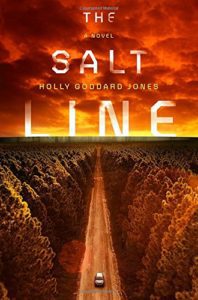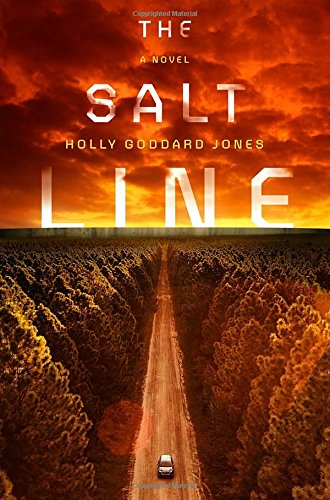 Editorial Assistant Sakinah Hofler: When I first saw my reading list for my Forms class, I noted the usual suspects—Woolf, Austen, Elliot, Zadie Smith—then I paused at one title, The Salt Line by Holly Goddard Jones. Knowing Jones from her collection of realistic stories (Girl Trouble), I was surprised by the first line of description for her latest book: “After the country’s borders have receded behind a salt line—a ring of scorched earth that protects its citizens from deadly disease-carrying ticks—a group of adrenaline junkies pay a fortune to tour what’s left of nature, no longer held captive by their society’s common fear.”
Editorial Assistant Sakinah Hofler: When I first saw my reading list for my Forms class, I noted the usual suspects—Woolf, Austen, Elliot, Zadie Smith—then I paused at one title, The Salt Line by Holly Goddard Jones. Knowing Jones from her collection of realistic stories (Girl Trouble), I was surprised by the first line of description for her latest book: “After the country’s borders have receded behind a salt line—a ring of scorched earth that protects its citizens from deadly disease-carrying ticks—a group of adrenaline junkies pay a fortune to tour what’s left of nature, no longer held captive by their society’s common fear.”
Holly Goddard Jones + dystopia + ticks? I was intrigued.
A brief rundown of the ticks in The Salt Line: the pregnant females burrow into the skin and by the time the person notices, the itching has already started. If the person doesn’t receive a stamp within sixty seconds of the burrowing (read: extract the female, kill the eggs, and sear their skin shut), the female’s babies will scatter throughout the body. The babies will cause the person to either scratch their skin off or, eventually, the baby ticks will tear their way out.
Nasty stuff.
Those who live behind the salt line in designated regional zones (i.e. Gulf Coast Zone, Atlantic Zone, etc.) are safe behind the charred earth and high walls. Those who have signed up for the Outer Limits Excursion? Not so much. With the exception of the zones, the ticks cover much of the landmass of the United States. These “adrenaline junkies” who dare cross the salt line participate for a myriad of reasons—some just want to see nature, some want to go for the adventure—but it’s those with complicated reasons Jones chooses to focus on: the one who’s there with her pop-sensation boyfriend, the child-genius CEO of a major corporation, and the wife of a mob boss. As with all good fiction, the biggest threat shifts from the environment to other people. Just when the excursion group thinks miner ticks will be their biggest worry, one of them is murdered and the rest of them are kidnapped by a town that has chosen to live outside the zones, among the ticks.
 Jones employs an omniscient narrator to give us insight into her characters so that we always know more than they do. As a result, we’re gnawing our nails down to the cuticles to try and figure out how and when the secrets will come out and what they will mean for the fates of the kidnapped as well as the kidnappers. Everyone seems to be searching for freedom, and what that actually means to each person causes conflict, mistrust, murder, etc..
Jones employs an omniscient narrator to give us insight into her characters so that we always know more than they do. As a result, we’re gnawing our nails down to the cuticles to try and figure out how and when the secrets will come out and what they will mean for the fates of the kidnapped as well as the kidnappers. Everyone seems to be searching for freedom, and what that actually means to each person causes conflict, mistrust, murder, etc..
While other writers might slip into the easy good guy/bad guy dichotomy, Jones doesn’t allow us to simplify. For example, one of the kidnappers, Violet, grew up in a world of abuse and sex trafficking, and here’s how gently Jones handles her story:
Violet doesn’t know that Teddy, who’d acted in offering to help Shaquoia on a vague well-meaning impulse—he was a devout Pentecostal, had always felt guilty about patronizing the Flat Rock camp, though not guilty enough to stop—panicked shortly after smuggling Violet out. . . . Teddy was able to soothe himself with the belief that this was part of God’s plan, and if the child were meant to survive, God would protect her. If she didn’t—well, paradise would be her reward.
The Salt Line offers its readers that beautiful blend of literary and genre, of sentence- and global-level control. I cannot tell you what happens in the end, but I guarantee you, each chapter offers surprise after surprise until you wind up in a place you’d never expect.
Sakinah Hofler is a PhD candidate at the University of Cincinnati, where she is a Yates Fellow. In 2016, she was shortlisted for the Manchester Writing Competition. She received her MFA from Florida State University, where she was awarded a Kingsbury Fellowship. Her work has appeared in Hayden’s Ferry Review, Eunoia Review, and Counterexample Poetics. A former chemical and quality engineer, she now spends her time teaching and writing fiction, screenplays, and poetry.











